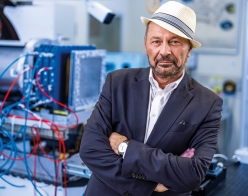
Image credit: M. Sterle/ICTP Photo Archives
On 23 July, the Italian–Argentinian theorist Miguel Ángel Virasoro, one of the founders of string theory and an initiator of complexity studies, passed away. His scientific contributions were outstanding and stimulated an impressive number of subsequent developments. He was an extraordinarily intelligent visionary with a great sense of humour.
Born in Buenos Aires in 1940, Virasoro enrolled in physics at the University of Buenos Aires in 1958. However, in 1966 General Juan Carlos Onganía successfully led a coup d’état in Argentina, establishing a dictatorship that would last until 1973. The faculty of science at Buenos Aires became a centre of opposition: the police broke into the university, massacring the occupants. In the following months, some 300 professors emigrated abroad.
Virasoro finished his thesis working from home; at the end of 1966, as soon as he obtained his doctorate, he moved to the Weizmann Institute, Israel, invited by a newly appointed young Argentinian professor, Hector Rubinstein. A few months earlier, Gabriele Veneziano had also arrived as a graduate student. The three of them, together with Marco Ademollo, began a long series of investigations into the physics of strong interactions that eventually led to string theory. Although the first step towards string theory was Veneziano’s “open-string” model in 1968, those preliminary results established the conceptual framework in which Veneziano’s model could be conceived. A few months later, stimulated by Veneziano’s work, Virasoro extended it to a model describing closed strings.
The Virasoro condition
In the following years, first at the University of Wisconsin, then at Berkeley, Virasoro did brilliant work on string theory. In 1969 he made the fundamental observation that string theory could only be made free of pathologies by fixing a certain parameter. This “Virasoro condition” allowed for the existence of an infinite number of symmetries generated by an infinite set of operators obeying a “Virasoro algebra” – a tool at the basis of countless subsequent studies. The Virasoro condition proved to be a killer for string theory as a description of strong interactions, but it opened the way to the 1974 Scherk–Schwarz reinterpretation of it as a quantum theory of gravity, in which one particular closed string corresponds to the graviton.
In 1973 democracy was restored in Argentina; Virasoro returned to his own country and was elected, still very young, dean of the faculty of science in Buenos Aires, a politically exposed position. In 1975 he accepted an invitation to spend a year at Princeton. During his stay in the US, however, Videla’s 1976 coup d’état brought dictatorship back to Argentina, in a more cruel form than before: many professors and students were slaughtered at the university. Virasoro was not only fired, but he was told that, had he returned to Argentina, he would be arrested or worse.
Virasoro was convinced of the role that theoretical physics could have in building the capacity of developing countries
He moved to Europe, and after a year in Paris, arrived in Italy, first in Turin and then, from 1981, at La Sapienza in Rome, where he remained for 30 years as a full professor, taking Italian citizenship. Having started to investigate the relationship between the emerging theory of quarks and gluons (QCD) and string theory, in 1983 he changed direction. He began to work with Giorgio Parisi on the statistical mechanics of complex systems, first with other Parisian physicists (Marc Mézard, Nicolas Sourlas and Gerard Toulouse) and then with Mézard alone, who had moved to Rome for two years. The group obtained important results on which the bases of the physical theory of complexity rest and also wrote a book on these results. In 1988 Virasoro became passionate about studying how, starting from neural networks, we can understand the functioning of the brain.
From 1995 to 2002 he was called to direct the International Centre for Theoretical Physics (ICTP) in Trieste. Sharing the vision of its founder Abdus Salam, Virasoro was convinced of the role that theoretical physics could have in building the capacity of developing countries. He decided to enlarge and diversify ICTP’s scientific programme. Within the condensed-matter group, he established a strong subgroup in statistical mechanics and its applications, which was the beginning of quantitative biology. He established a joint project with the Beijer Institute and the Fondazione Eni Enrico Mattei in environmental and ecological economics, and founded an ICTP group devoted to the physics of weather and climate. He also succeeded in rendering compulsory the Italian contribution to the ICTP, and securing a significant increase in the contribution in 2000.
Back in Rome, in the last years before his 2011 retirement, he worked on applications of physical theories to finance, an activity that he continued in Argentina, where he returned, at the Universidad Nacional de General Sarmiento. In 2009 he received the Enrico Fermi Prize from the Italian Physical Society and in 2020 was awarded the ICTP Dirac medal for his work on string theory.
Miguel Virasoro cherished the ability to use knowledge learned in one field to make progress on a different one, opening up new vistas. He will be sorely missed.








